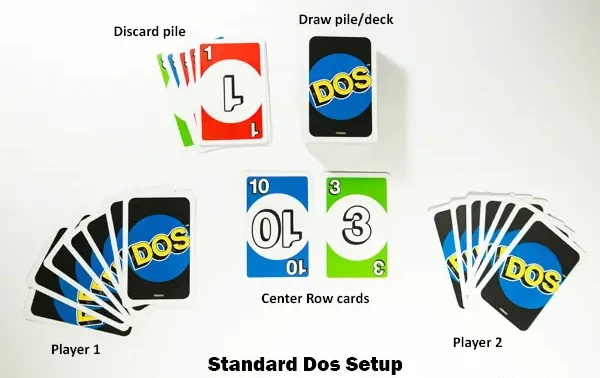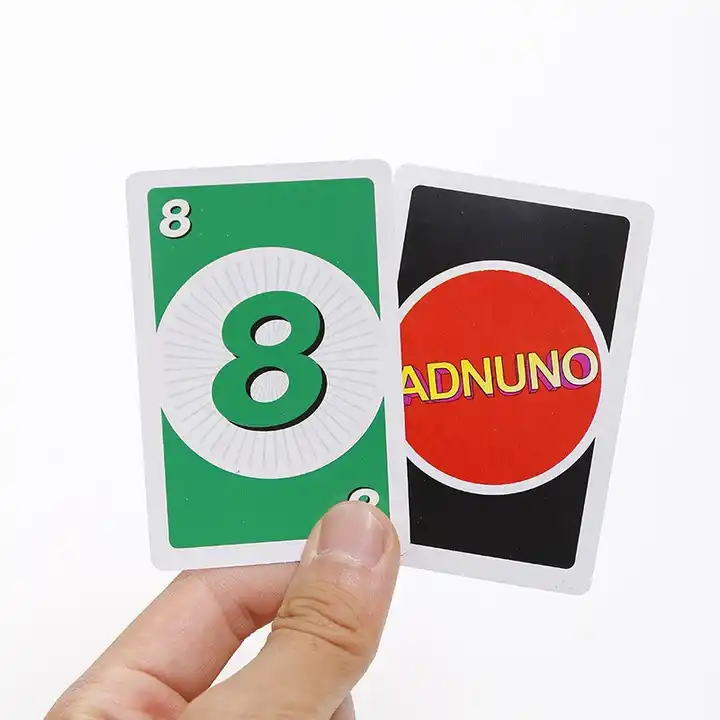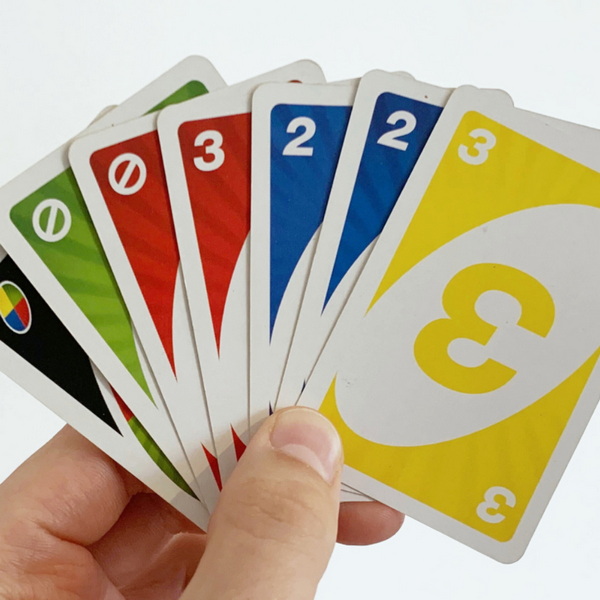Content Menu
● Introduction
● Game Components
● Setup
● Objective
● Gameplay
>> Basic Turn Structure
>> Matching Cards
>> Special Cards
>> The "DOS" Rule
>> Ending a Turn
● Scoring and Winning
● Strategies for Success
● Differences from UNO
● Conclusion
● Common Questions and Answers
>> 1. How many cards are dealt to each player at the start of a DOS game?
>> 2. What happens if a player forgets to say "DOS" when they have two cards left?
>> 3. How do you win a game of DOS?
>> 4. What is a Color Match Bonus in DOS?
>> 5. How do the Wild DOS and Wild # Symbol cards work?
● Citations:
Introduction
DOS, the exciting sequel to the classic card game UNO, brings a fresh twist to family game nights. Created by Mattel, this fast-paced card game challenges players to match numbers and colors while introducing new strategic elements. In this comprehensive guide, we'll explore the rules, gameplay mechanics, and strategies to help you master DOS and become the ultimate card-slinging champion.

Game Components
Before diving into the gameplay, let's familiarize ourselves with the components of DOS:
- 108 cards in total
- 24 cards each in Blue, Green, Red, and Yellow
- Each color set includes:
- 3 each of 1, 3, 4, and 5
- 2 each of 6, 7, 8, 9, and 10
- 2 Wild # cards
- 12 Wild DOS cards
Setup
To begin your DOS adventure, follow these setup steps:
1. Shuffle the deck thoroughly.
2. Deal 7 cards to each player.
3. Place the remaining cards face-down to form the draw pile.
4. Flip over the top two cards from the draw pile to create the center row.
5. The player to the left of the dealer starts the game.
Objective
The primary goal in DOS is to be the first player to discard all your cards in each round. Points are earned based on the cards remaining in your opponents' hands. The first player to reach 200 points (or any agreed-upon score) wins the game[5].
Gameplay
Basic Turn Structure
On your turn, you must perform one of the following actions:
1. Match one or both cards in the center row.
2. Draw a card from the draw pile if you can't make a match.
Matching Cards
Unlike UNO, DOS focuses primarily on number matching. Here are the ways you can match cards:
1. Single Match: Play a card from your hand that has the same number as one of the center row cards[1].
2. Double Match: Use two cards from your hand that add up to the number on a center row card. For example, you can match a 7 in the center row by playing a 3 and a 4 from your hand[1].
3. Color Match Bonus: If the card you play matches both the number and color of a center row card, you earn a color match bonus. This allows you to place an additional card from your hand into the center row[2].

Special Cards
DOS introduces two special cards that can change the course of the game:
1. Wild DOS Card: This card counts as a 2 of any color. You decide its color when you play it[1].
2. Wild # Symbol Card: This card can represent any number from 1 to 10 in its color. You determine its value when you play it[1].
When either of these wild cards is face-up in the center row, you decide its color or number when matching to it[1].
The "DOS" Rule
One of the most crucial rules in DOS is calling out "DOS" when you have exactly two cards left in your hand. If you forget to say "DOS" and another player catches you, you must immediately draw two cards as a penalty. However, if it's currently your turn, you wait until the end of your turn to draw the penalty cards[1][6].
Ending a Turn
After playing your cards or drawing from the pile, follow these steps to end your turn:
1. Discard any piles in the center row with more than one card.
2. Leave single cards in the center row.
3. If there are fewer than two cards in the center row, draw from the pile to ensure two cards are face-up[1].
Scoring and Winning
When a player discards all their cards, the round ends. Points are then calculated based on the cards remaining in other players' hands:
- Number cards (1, 3-10): Face value
- DOS card: 20 points
- Wild # Symbol card: 40 points[1]
The first player to reach or exceed 200 points wins the game. If no player has reached 200 points, shuffle all cards and begin a new round, with the previous round's winner dealing[1].
Strategies for Success
To improve your chances of winning at DOS, consider these strategic tips:
1. Manage your hand: Try to keep a balanced mix of numbers and colors to increase your matching opportunities.
2. Use double matches wisely: Double matches can help you discard cards faster, but be cautious not to leave yourself vulnerable.
3. Pay attention to color match bonuses: These can significantly accelerate your progress, allowing you to discard multiple cards in one turn.
4. Be mindful of wild cards: Use them strategically to create advantageous situations or block your opponents.
5. Keep track of your opponents' cards: This can help you anticipate their moves and adjust your strategy accordingly.
6. Don't forget to say "DOS": Always be aware of your card count to avoid drawing penalty cards.
7. Play low-value cards early: In the early game, it's often wise to play cards with small numbers, as they are less likely to be matched by your opponents using two cards[5].
Differences from UNO
While DOS shares some similarities with its predecessor, there are key differences to keep in mind:
1. DOS focuses on number matching rather than color matching.
2. There are at least two discard piles (center row) instead of one.
3. Players can make double matches by combining two cards.
4. The special cards (Wild DOS and Wild #) function differently from UNO's wild cards.
5. The "DOS" rule replaces UNO's "UNO" rule when a player has two cards left.
Conclusion
DOS offers an exciting twist on the classic UNO formula, introducing new mechanics and strategies while maintaining the fun, fast-paced nature of its predecessor. By mastering the art of number matching, utilizing special cards effectively, and staying alert to call "DOS," you'll be well on your way to becoming a DOS champion. Whether you're playing with family or friends, DOS promises hours of entertainment and friendly competition.

Common Questions and Answers
1. How many cards are dealt to each player at the start of a DOS game?
Each player is dealt 7 cards at the beginning of the game[2].
2. What happens if a player forgets to say "DOS" when they have two cards left?
If a player forgets to say "DOS" when they have two cards left and another player catches them, they must draw two cards as a penalty. If it's currently their turn, they draw the penalty cards at the end of their turn[1][6].
3. How do you win a game of DOS?
The first player to reach 200 points (or any agreed-upon score) wins the game. Points are earned by being the first to discard all cards in a round and scoring based on the cards left in other players' hands[5].
4. What is a Color Match Bonus in DOS?
A Color Match Bonus occurs when a player matches both the number and color of a card in the center row. This allows the player to place an additional card from their hand into the center row[2].
5. How do the Wild DOS and Wild # Symbol cards work?
The Wild DOS card counts as a 2 of any color, while the Wild # Symbol card can represent any number from 1 to 10 in its color. The player decides the color or number when playing these cards[1].
Citations:
[1] https://www.youtube.com/watch?v=jSSX3J50y88
[2] https://shsulibraryguides.org/c.php?g=1162121&p=9092676
[3] https://www.youtube.com/watch?v=IDJZ70gCBYc
[4] https://www.themindcafe.sg/product/uno-dos-card-game/
[5] https://www.unorules.com/dos-rules/
[6] https://64-ounce-games.myshopify.com/pages/dos-rules
[7] https://www.youtube.com/watch?v=KFfgcaLRyW8
[8] https://service.mattel.com/instruction_sheets/FRM36-Eng.pdf
[9] https://www.youtube.com/watch?v=ZQIBEUb237A
































